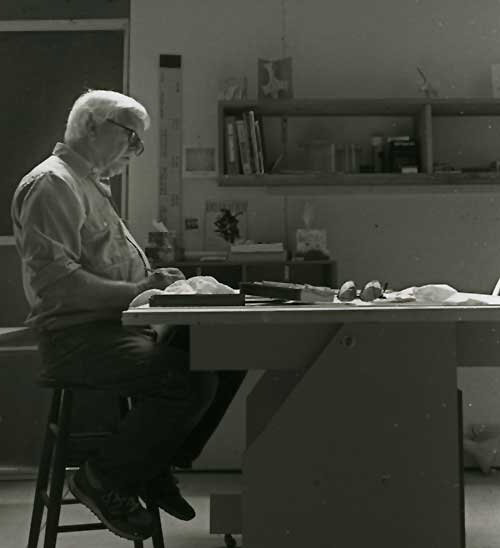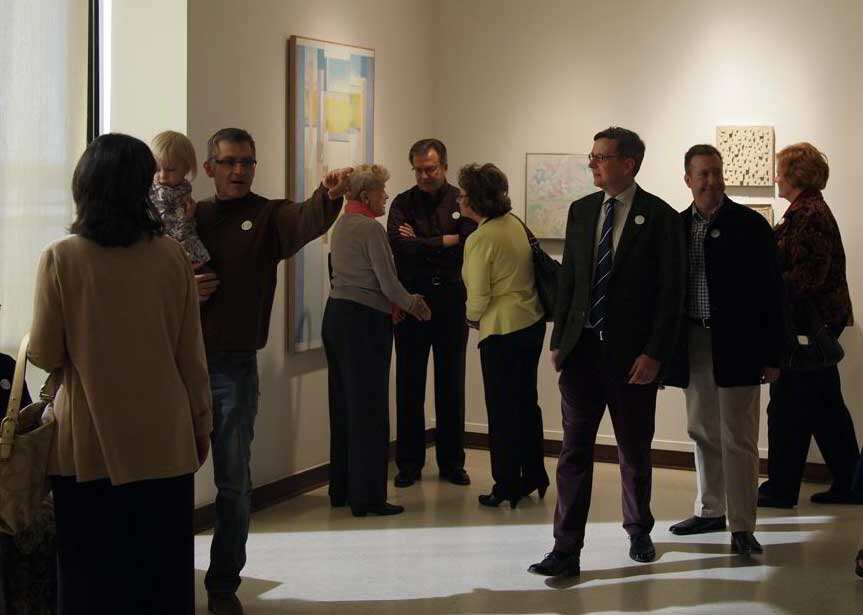biography
John Clemmer was born in 1921 on a plantation in southern Louisiana near the small town of Donaldsonville. His father, a Wisconsin native, married a daughter of a French-speaking family which traced its presence in Louisiana back to the 18th century. In 1928, the family relocated to New Orleans, where Clemmer received a public education. Following his graduation from high school, Clemmer was awarded a scholarship to the New Orleans Art School. He moved to the French Quarter and began his studies with Paul Ninas, Xavier Gonzales, Enrique Alferez, and others. He served in the U.S. Army Air Corps between 1944 and '46 before returning to New Orleans where he resumed residency in the French Quarter and his involvement with the city's arts community.
By 1946, Clemmer was Executive Secretary of the New Orleans Arts and Crafts Club – the city’s first contemporary art gallery – and Director of the affiliated New Orleans School of Art. It was through classes at the New Orleans School of Art that Clemmer met his future wife, Dorothy Iker, a native of Chicago. They were married in 1953, and began spending summers at the Iker family cottage outside of Sheboygan, Wisconsin, near the shores of Lake Michigan. They later acquired the adjoining property where they renovated a second cottage, and built a studio which Clemmer designed. The Arts & Crafts Club and its school folded in 1951 following the passing of its primary benefactor, the sugar refinery heiress Sarah Henderson.
 John Clemmer at Work
John Clemmer at Work
Clemmer’s long affiliation with Tulane University began in 1951 when he accepted a position as Instructor of Drawing, Painting and Basic Design in the School of Architecture. Several years later, he taught Art Fundamentals in the Department of Art of Newcomb College, at that time the women’s college of Tulane University. Clemmer remained a full-time member of the faculty of the School of Architecture for 27 years, attaining the rank of assistant professor in 1959, associate professor in 1966, and full professor in 1974. He maintained a studio in the school as it transitioned to the Richardson Memorial building—an indication of his unique status as the faculty's resident artist. When he left in 1978, it was to become the Chairman of the Newcomb Art Department, a position he held until his retirement from Tulane in 1986 as Professor Emeritus. During his Newcomb tenure, he became the first recipient of the Ford and Maxine Graham Chair in Fine Art.
Throughout his long academic career, Clemmer maintained a studio away from the University, initially in the French Quarter and later at the Clemmer family home on the Uptown edge of the Irish Channel. He exhibited his work regularly at two-to-three-year intervals in local and regional galleries throughout the ’50s, ’60s, and ’70s, including several shows in the historic Clemmer residence. As his academic responsibilities increased, the solo exhibitions became less frequent, although he continued to show in group exhibitions locally, nationally, and internationally. Following his retirement from academe, Clemmer turned his full attention to his studios in New Orleans and at the family property in Sheboygan, Wisconsin.
Over the course of his fifty-plus years as a artist, the range of Clemmer’s work was been extraordinarily diverse, reflecting a restless and highly personal investigation of the modernist enterprise. Style, subject matter, and media evolved steadily over the years, and many influences and inspirations informed his work. Clemmer’s work of the 1940s evidenced a Cubist sensibility in his approach to form and space, while retaining a connection with the traditions of still life, figure, and landscape painting. In the 1950s, he produced large abstractions on Masonite panel, and many works on paper with a particular focus on portraits and nude figure studies. Landscape-inspired abstraction dominated Clemmer’s output in the 1960s, marking the development of a theme in his work that carries through to the present day. A hard-edge geometric style inspired by Byzantine illuminated manuscripts of the fifth and sixth centuries is prominent in the large paintings of the later 1960s and 1970s, gradually evolving into the softer, more impressionistic feel that typified the work of the ’80s and ’90s.

A grounding in studio skills provided a solid foundation for every aspect of Clemmer’s artistic journey. Figurative subject matter emerged, disappeared, and re-emerged, and Clemmer’s oeuvre includes articulate pencil renderings and portraits in addition to a significant body of abstraction. In later years, an ongoing series of large-scale studies of the effects of changing light on the countrysides of Greece and Italy, where the Clemmers traveled extensively, has been a major component of his output in the 1990s. These paintings complement a parallel series of canvases evocative of the rural southern Louisiana landscapes of Clemmer’s childhood, and the birch forests and Lake Michigan shoreline of Wisconsin.
Although thought of by many exclusively as a painter, Clemmer also produced an extensive body of three-dimensional work. Beginning in 1949, Clemmer was the recipient of numerous commissions for works in both public and private venues, executed in a wide variety of media. Included among the commissions were a series of religious sculptures for synagogues in Evanston, Illinois, and New Orleans, a group of fountains incorporating bronze panels and sand/plaster castings, and several monumental sand/plaster murals. Dozens of smaller works in metal, plexiglass, wood, and sand/plaster casting have emerged from his studio as well.
In October of 1999, Clemmer’s achievements were presented in their fullest context to-date when the New Orleans Museum of Art opened 'John Clemmer: Exploring the Medium, 1940 – 1999,' a major retrospective documenting sixty years of the artist’s work. The exhibition, the accompanying catalogue, and a twelve-minute documentary film titled 'John Clemmer: Sculpture' were enthusiastically received.
 “John Clemmer: New and Selected Work,” Louisiana Art and Science Museum, Baton Rouge, March, 2012
“John Clemmer: New and Selected Work,” Louisiana Art and Science Museum, Baton Rouge, March, 2012
Between 1999 and 2013, Clemmer divided his time equally between his studios in New Orleans and Sheboygan, Wisconsin. He continued to work in a variety of media on canvas and on paper, often employing collage elements. In May of 2010, Clemmer was presented the Louisiana Artist Recognition Award by the Delgado Society of the New Orleans Museum of Art, and in March 2012 the Louisiana Art and Science Museum in Baton Rouge mounted the exhibition 'John Clemmer: New and Selected Work.' In February of 2012 Clemmer suffered a serious illness but recovered fully and was able to return to the studio in the spring of that year. In 2013 the Clemmers decided to move to Wisconsin full-time. They divided their time between their home and studio in the woods outside of Sheboygan and an apartment in Milwaukee. During the summer of 2013 Clemmer began applying himself to works on paper in colored pencil, pastel and watercolor. A selection of these works and other recent material were presented in January, 2014, at the LeMieux Galleries in New Orleans.
John Clemmer passed away on April 11, 2014, in Milwaukee, Wisconsin. He was 92 years old.
In 2021, The Historic New Orleans Collection presented 'John Clemmer: A Legacy in Art,' a retrospective exhibition mounted to commemorate the centennial of the artist's birth. The exhibition included 62 works by the artist and was accompanied by a complimentary exhibition of work by Clemmer's teachers, contemporaries, students and colleagues. The HNOC published a 148-page catalogue for the exhibition and the artist's son David created a 22-minute documentary film to mark the occasion.

